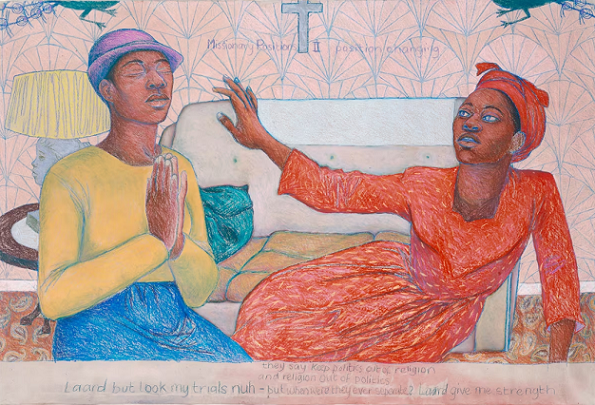
Kate Taylor (Globe and Mail) reviews “Life Between Islands: Caribbean-British Art 1950s-Now,” which is on view (on loan from the Tate Britain-London) until April 1, 2024, at the Art Gallery of Ontario (AGO) in Toronto, Canada. [Also see previous posts Life Between Islands: Caribbean-British Art.AGO and Life Between Islands. Many thanks to Peter Jordens for bringing this item to our attention.]
Historians say the Caribbean carnival tradition has some of its roots in the celebrations of liberated slaves. One theory about the elaborate costumes, familiar to anyone who has attended Toronto’s Caribbean Carnival or the Notting Hill Carnival in London, is that they originally satirized the excesses of the former masters. The point was both taking control of the streets and being seen on one’s own terms: Surveillance and stereotype are replaced with joyful exhibition.
No surprise then that a show of Caribbean diaspora art from the U.K., organized by the Tate Britain and visiting the Art Gallery of Ontario, is not a collection of abstract paintings. Life Between Islands features art from the 1950s to the present and is all about representation, artistic, political and existential.
Take, as just one example, the drawings of contemporary Birmingham artist Barbara Walker that include fine charcoal portraits of her son from different angles drawn on the police forms issued during repeated street checks, which she found hidden in his bedroom.
The Windrush generation, named for a migrant ship that arrived in 1948, represented the high-water mark of Caribbean immigration in the 1950s and 1960s before the British government passed more restrictive laws, but there were also earlier arrivals who had established an artistic community by the 1920s and 1930s.
The first section of this exhibition, starting with a massive female head carved from elm wood in 1937 by Ronald Moody, deals briefly with an older generation working in a modernist context. Artists such as Aubrey Williams, represented by surreal semi-abstractions, and colour-field painter Frank Bowling brought a distinctive approach to the art movements of the day. Williams was one of several artists acquainted with the Indigenous Amazonian culture of their native Guyana; Bowling incorporated personal and political figurative content into his work, including his cheeky take on pure abstraction, Who’s Afraid of Barney Newman.
But in this exhibition, it is the return to representation in the 1980s that liberates a younger generation to create an explosive new current in British art. Of course, there is no shortage of photojournalism, including famed images of Black activism and social life by Charlie Phillips, Horace Ové, Neil Kenlock, Vanley Burke and Dennis Morris. Yet it’s in the fine-art tradition that some of the strongest statements about representation emerge such as Sonia Boyce’s 1980s portraits, with their provocative combination of the literal and the symbolic.
One is a double self-portrait, Missionary Position II, juxtaposing a pious figure with a freer one in a colourful head wrap. Another plays cleverly with perspective as Boyce depicts herself as a figure of strength holding her family up on her raised palms.
From 1983, Claudette Johnson’s untitled and almost monochromatic pastel and gouache drawing of two women, based on photographs of people in the crowd at a protest, shows a pair of furrowed faces with expressions so ancient they look like weathered monuments.
As well as the portraits of her son, Walker contributes a highly realistic oil painting, a closeup on a young woman having her hair braided. All of these works offer the viewer direct encounters with powerful figures unbowed by racism.
The exhibition continues into the present including a large multimedia wall panel by Marcia Michael, part of her continuing The Object of My Gaze project: Against a photo mural of a lush Jamaican landscape, she hangs intimate photographs of her mother’s great body. There is also work by the Bahamian artist Blue Curry that comments on the confining expectations of making art in a tourist economy and adopts traditional materials now only used to make souvenirs. Caribbean Queen, named for the Billy Ocean song, features a giant fan of palm fronds, like the headpiece on a carnival costume, interwoven with the magnetic cassette tape.
Carnival, surveillance and representation, these themes all come together in one of the most remarkable moments of the show. Passing by a dark corner too quickly, you might mistake Chris Ofili’s painting Blue Devils as an indigo abstraction but if you spend a bit of time with the large 2014 painting, figures emerge. They are the unsettling Blue Devils of the Trinidadian carnival tradition, characters who paint their bodies blue and threaten other revellers. Here, another shadowy figure appears behind them with the distinctive checkerboard hat band worn by the British police.
Hung against a deep indigo wall to make the viewer work even harder to grasp the subject, the painting offers a distinctive metaphor for being seen, noting both the official surveillance of Black lives but also the social discounting of Black life. Here, art is the best retort.
For original article and photos, see https://www.theglobeandmail.com/arts/art-and-architecture/article-new-ago-exhibit-life-between-islands-highlights-caribbean-diaspora-art
Also see “A Tate Britain exhibition featuring the works of Caribbean artists is on display in Toronto until April,” Rachel Goodman, Now Toronto: https://nowtoronto.com/news/a-tate-britain-exhibition-featuring-the-works-of-caribbean-artists-is-on-display-in-toronto-until-april
[Shown above: Sonia Boyce, “Missionary Position II,” 1985. Watercolour, pastel and crayon on paper, Support: 123.8 × 183 cm. Tate. Purchased 1987. T05020. © Sonia Boyce (Copyright Visual Arts-CARCC, 2023) Photo: Tate.]
Kate Taylor (Globe and Mail) reviews “Life Between Islands: Caribbean-British Art 1950s-Now,” which is on view (on loan from the Tate Britain-London) until April 1, 2024, at the Art Gallery of Ontario (AGO) in Toronto, Canada. [Also see previous posts Life Between Islands: Caribbean-British Art.AGO and Life Between Islands. Many thanks to Peter Jordens for bringing







